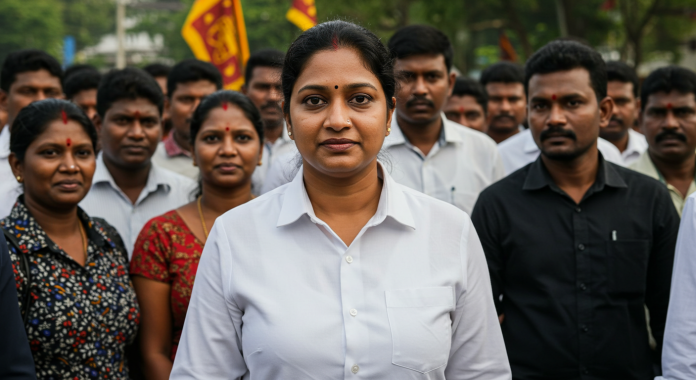South Asian Women in Media – Sri Lanka (SAWM-SL), in collaboration with the Free Media Movement (FMM), the Sri Lanka Working Journalists’ Association (SLWJA), The Editors’ Guild of Sri Lanka (TEGSL), and the Sri Lanka Press Institute (SLPI), observed International Women’s Day 2025 with a half-day event titled ‘Improving Media Engagement with Women in Politics in Sri Lanka,’ aimed at enhancing media engagement with women in politics.
The event, held at the Sri Lanka Press Institute auditorium on 12 March, brought together journalists, media professionals, and members of SAWM-SL, along with women political leaders, activists, and media editors. It provided a platform for discussions on women’s political participation and the role of the media in shaping public perception and engagement.
A special tribute was paid to the late senior journalist and SAWM-SL’s Senior Advisor, Seetha Ranjanee, in recognition of her contributions to journalism and women’s rights.
Dr Chulani Kodikara, a researcher at the Social Scientists’ Association and Co-Editor of Polity (SSA Magazine), delivered the opening remarks, contextualising the discussion within the framework of the recently concluded elections. Highlighting the persistent underrepresentation of women in politics, she noted:
“Given that the representation of women in Parliament has stagnated at around 5% for more than 40 years, the fact that the NPP was able to increase representation in Parliament without any quota or reservation is truly an achievement that we need to recognise and applaud. We must also celebrate that, for the first time in our history, two women from the Malaiyaha Tamil community were elected to Parliament in 2024.”
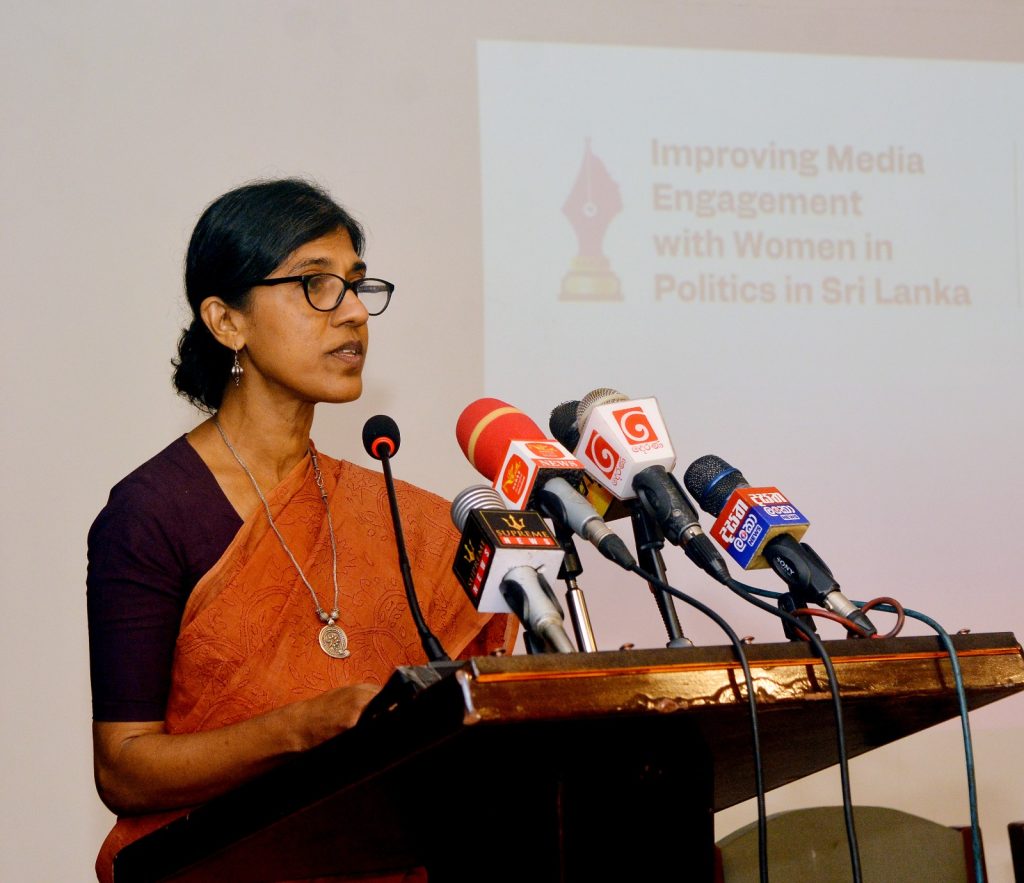
Juxtaposing this increase in women’s representation in Parliament with the dramatic rise in women’s representation in local government—from 2% to 25% following the introduction of a quota for women in 2016—she emphasised that this was achieved through a long struggle waged not by party women but by women’s organisations in Sri Lanka.
However, even as these gains are celebrated, she stressed that much more needs to be done to increase women’s numerical representation in politics. She pointed out that women’s representation in formal political institutions remains low compared to other South Asian countries and that, despite the increase in the number of women in Parliament, they continue to be underrepresented in the Cabinet and leadership positions within political party structures.
Emphasising the media’s role in shaping narratives around women in politics, she noted that research indicates female politicians receive less media coverage and are often portrayed in gendered, sexualised, or stereotyped terms. She also observed that the media reinforces traditional gender norms, positioning women within the domestic sphere while aligning men with political leadership.
“The media are also less open to the concerns and achievements of women politicians than to those of their male counterparts,” she said, adding that the rise of social media has exacerbated harassment and hate speech against women politicians, posing a significant barrier to their participation in public life.
Panel Discussions
Following the opening observations, two panel discussions explored the challenges faced by women in politics and the media’s role in fostering greater representation.
Panel 1: Challenges and Experiences of Women in Politics
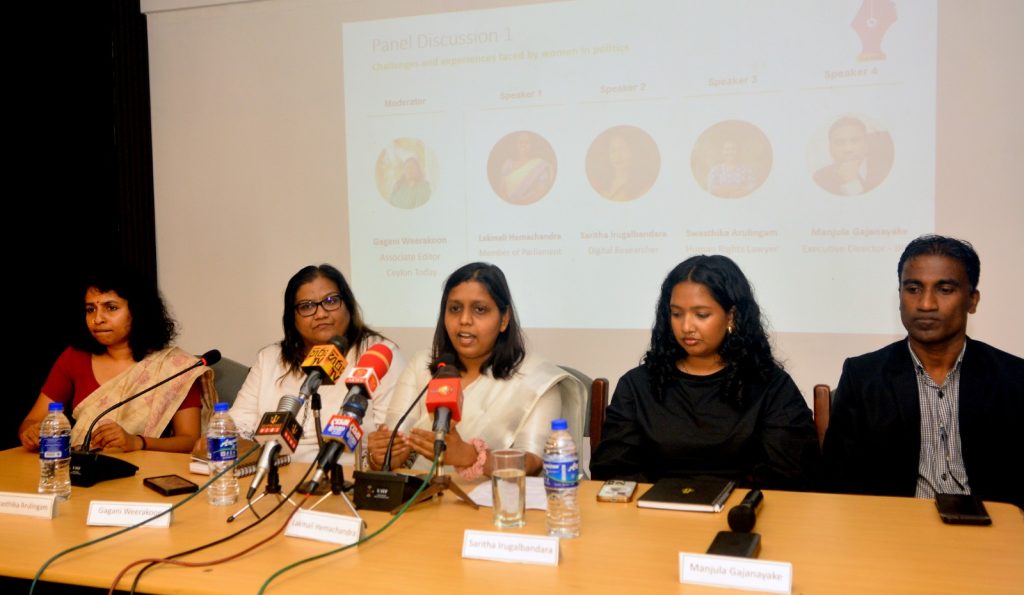
- Lakmali Hemachandra, MP (NPP)
- Swastika Arulingam, Human Rights Lawyer & Parliamentary Candidate (People’s Struggle Alliance)
- Saritha Irugalbandara, Digital Researcher & Activist
- Manjula Gajanayake, Executive Director, Institute for Democratic Reforms & Electoral Studies
Panel 2: Looking Ahead—Increasing the Voices of Women in Public Life
- Lihini Fernando, Lawyer & Former Municipal Councillor (SJB)
- Piumi Attygalle, Deputy Commissioner, Election Commission
- K.W. Janaranjana, Editor, Anidda Newspaper & EGSL Representative
- Tharindu Uduwaragedara, Journalist & National Organiser, Federation of Media Employees Trade Union
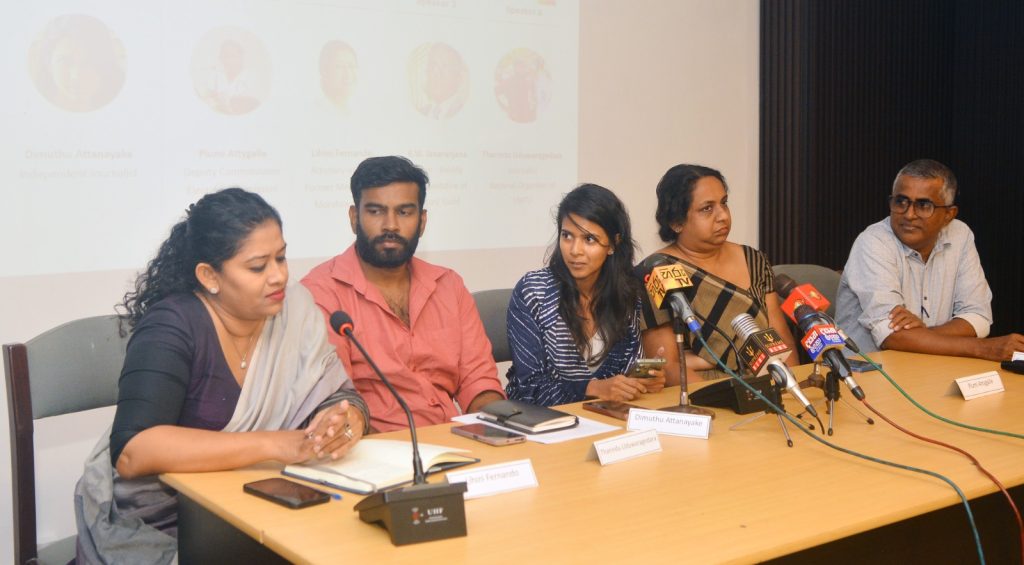
The panel discussions were moderated by Gagani Weerakoon, Associate Editor of Ceylon Today, and Dimuthu Attanayake, Independent Journalist & Pulitzer Center Grantee. The event was facilitated by Kamanthi Wikramasinghe, Deputy Features Editor, Daily Mirror.
Political Barriers and Media Representation
MP Lakmali Hemachandra highlighted the deep-seated biases within political parties that view women as liabilities rather than capable leaders.
“Women are not considered important or capable of being in power. That is obvious when you look at the recent political landscape,” she said, pointing to challenges such as fundraising difficulties and negative media portrayals.
“The way the media represents women in politics is often damaging. Sometimes, it’s even deliberate. This discourages aspiring female politicians, and the media needs to rethink its role,” she added. Despite these barriers, she acknowledged progress: “There are more women in Parliament now, and they are speaking up. That’s a good sign.”
Structural Challenges and the Female Quota
Swastika Arulingam addressed the exclusion of women from political processes, pointing out that many parties neglect women in campaigns. She referenced a protest at the Election Commission where women raised a symbolic shoe to highlight the failure of electoral mechanisms in safeguarding women’s rights.
“The female representation quota is a good step because it has given opportunities to women. But the problem is that some parties recruit women just to meet this requirement, not because they genuinely believe in their capabilities,” she explained.
Manjula Gajanayake highlighted Sri Lanka’s long-standing gender disparity in politics.
“Since 1947, we’ve had 17 parliamentary elections and around 2,600 parliamentarians elected. But do you know how many women are among them? Only 146. That number speaks volumes about the systemic barriers women face in politics,” he said.
Social Media and Gendered Harassment
Saritha Irugalbandara highlighted the impact of digital harassment, noting that online misogyny is a major deterrent for women entering politics. “Women in politics and activism face relentless harassment on social media. During a research study, we found that although women were highly visible in the protest movement, 60% of gender-based violence on social media was targeted at them.”
She stressed that addressing online abuse requires more than legal measures: “Laws alone won’t tackle this issue. Just like in physical spaces, digital harassment silences women. We need more research and proactive interventions to change this culture.”
Breaking Barriers to Representation
The second panel focused on the ongoing challenges faced by women in politics and the role of the media in amplifying their voices.
Lihini Fernando asserted that women’s representation in politics is no longer a debate but a necessity. “Women are not just figures; they have opinions, voices, and the capability to contribute to decision-making. Yet, they continue to be confined within gender roles, and those who step beyond them are often labelled ‘radical.’”
She argued that the 25% quota for women’s representation should not be a permanent fixture but a means to an end, pushing for greater institutional change. “Women’s representation should not be limited to elections. It must be embedded within political parties themselves, with clear regulations guiding them.”
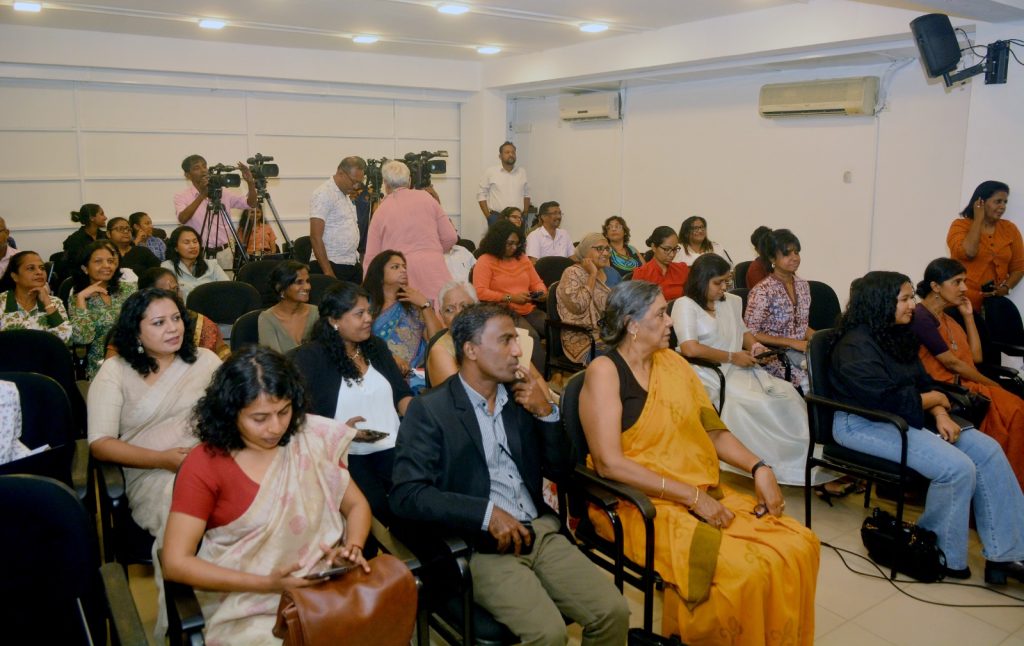
Since its establishment in 2009, SAWM-SL has led initiatives to mobilise women in media and enhance their influence as journalists and content creators. This event, organised in collaboration with leading media institutions, reaffirmed the collective commitment to fostering a more inclusive and representative media landscape that amplifies the voices of women in politics and public life.



